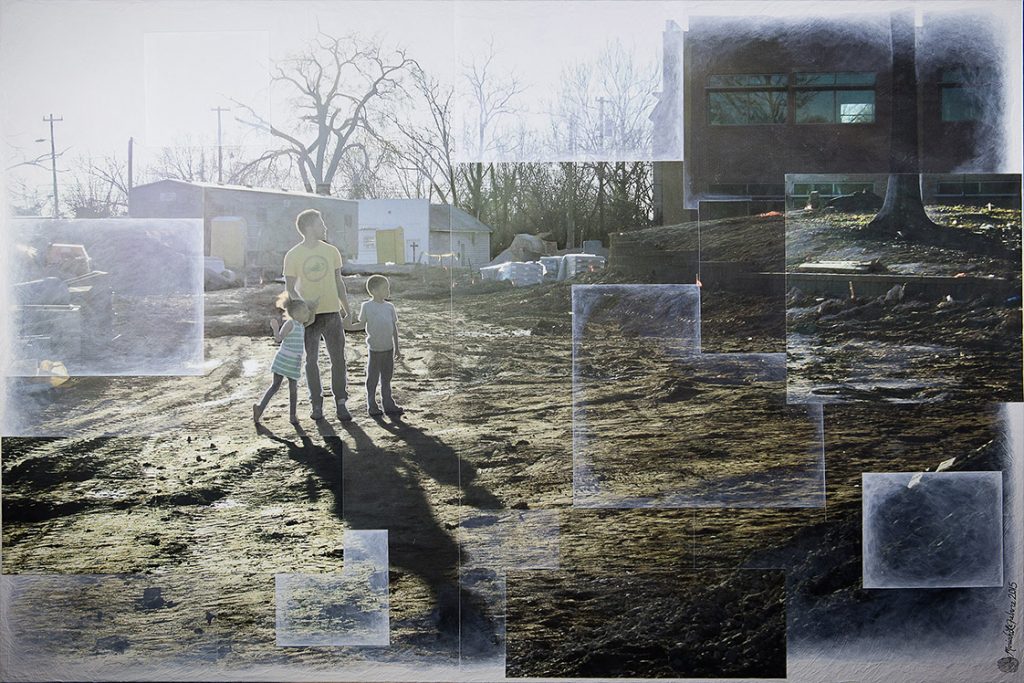
Durham Skywriter Pat Murray asks questions on a couple of Lefebvre’s pieces. “So you actually painted some of this photograph? I can’t tell. That’s amazing,” says Murray. (Staff photo by Cole McCauley)
Durham has been in a state of rapid development for decades. Old neighborhoods are torn down and reconstructed. Vacant blocks filled with rubble show projects that were started but never completed.
A local artist saw the Durham she grew up in changing before her eyes, so she spent a year creating art to reflect that change. After years of work, the walls of Through This Lens art gallery at 303 E. Chapel Hill Street were covered with unique multimedia projects. Each piece added a new perspective to the changes taking place in Durham.

Moriah Lefebvre sits inside the Through This Lens art gallery as the window pointing out towards inner city Durham bounces light off her face. “You can see where they are building the first Durham sky scraper from here. I’ve got to do a piece on that,” says Lefebvre. (Staff photo by Cole McCauley)
The “Hometown Inherited” art exhibit debuted February 19 and ended its run on March 15. Artist Moriah Lefebvre, who was born and raised in Durham, said her inspiration came from becoming a mother in early 2013.
“The lens of my world changed,” Lefebvre said. “As a new mother who was raising children in my own hometown – now their hometown – I found myself struck with the realization that the Durham of my childhood looks so different from the Durham of today, and that the Durham of today will look quite different from the Durham of tomorrow.”
“There used to be this field behind my house that we would always go play in. Now it’s been developed into a Harris Teeter. I realized that the field would never be there again. It would only be a memory,” Lefebvre said.
Each of Lefebvre’s pieces starts off as a photograph. She visits sites that are either being developed or which began to be developed but were never completed. She asks parents to bring their children and to roam the sites while she photographs them.
The art comes alive in the post-photography process.
“Each piece of art is composed of 20 to 30 different blocks. Some of them painted, some of them the original photograph and some are digitally enhanced,” Lefebvre said. “The point is to show that the piece of art is, in essence, being developed along with Durham and the families in Durham.”

Moriah Lefebvre’s “Kent Street” with Pierce Freelon and his two children. “In March 2015, I photographed a local dad with his two children at the site of the new Kent Corner. The construction on the Durham Co-Op Market was complete but the grocery store was not yet open. While the construction of the Center for Child and Family Health was nearing completion, its future parking lot remained a dusty field of dirt, full of rocks and rubble. The kids scampered up and down on the piles of rocks, laughing and kicking dust into the air. After they had gotten sufficiently dirty they took a moment to pause for me, holding hands with their father and looking at the new construction. The moment felt full of promise,” said Lefebvre. (Photo courtesy of Moriah Lefebvre)
Pierce Freelon, Durham born and bred, was a character in Lefebvre’s piece, “Kent Street.”
“I’ve known Moriah almost all my life. She texted me about her project on developing families alongside a developing Durham. It was interesting and I wanted to help,” Freelon said.
Lefebvre photographed Freelon with his son and daughter at the corner of Kent Street near the Durham Co-Op. In the photograph, they stand in a dusty parking lot holding hands while gazing at the construction.
Freelon’s experience with development in Durham is similar to Lefebvre’s.
“Across from South Square mall there used to be this arcade,” Freelon said. “I would always go over there and play games. Now it’s a Target and a Sam’s Club. That’s kind of boring.”
Freelon sees the problem of gentrification expressed in Lefebvre’s work.
“I grew up over near the St. Teresa neighborhood, close to ‘Black Wall Street.’ It’s radically different now. A lot of those houses were bought, boarded up, torn down and transformed to fit a different group of people. This is happening everywhere in Durham, and Lefebvre’s art can be a voice to it,” he said.
Some of Lefebvre’s pieces show empty neighborhoods, once active and occupied. Others show buildings that were torn down and never built back up, leaving rubble in the streets.
“The cost of living in Durham is increasing; condos are going up everywhere, and the lower-level working class can’t afford to live where they’ve grown up their whole lives. These people often don’t get to be part of the conversation about development,” says Lefebvre. “I definitely don’t want to push any specific thought to influence somebody in my art. I just want them to be aware of the development around them.”
“Hometown Inherited” will be on display May 5 through June 20 at Urban Durham Realty at 401 Foster St. A Reception will take place from 10 A.M. to 12 P.M. on May 21.
Lefebvre also anticipates continuing her work. She says many people have expressed to her how meaningful the collection is for them.
“Our first skyscraper in inner-city Durham is going up a block from this gallery. How could I not do a piece on that?” she said.
“So, I’m going to keep going.”
This project was made possible by the Ella Fountain Pratt Emerging Artists Grant from the Durham Arts Council with support from the North Carolina Arts Council.